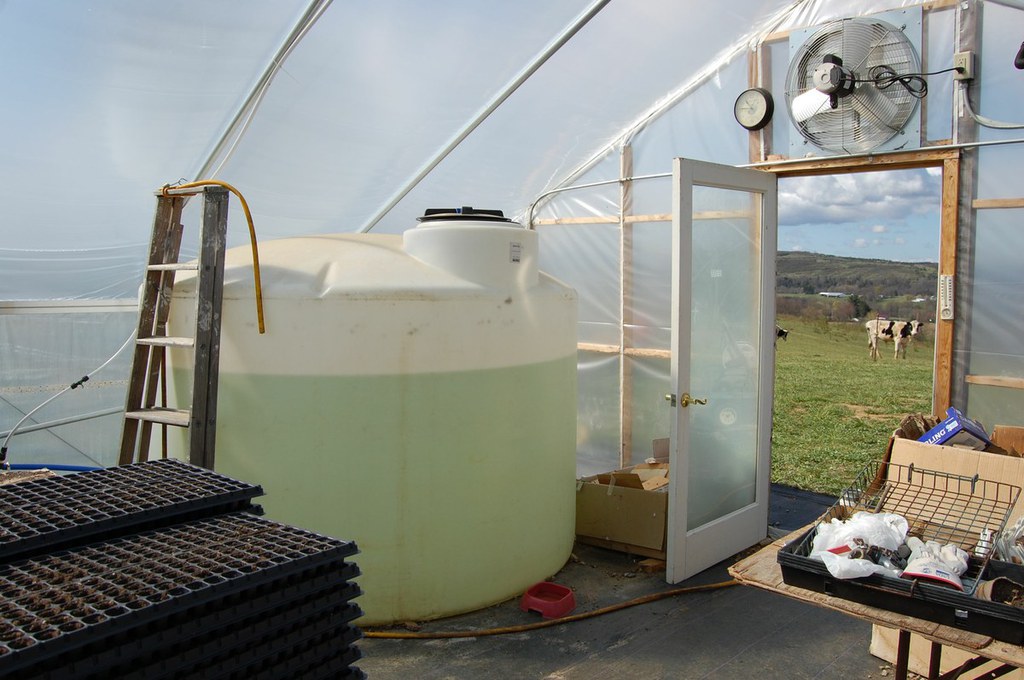Tips from experienced organic greenhouse farmers on how to keep your plants healthy in the greenhouse environment.
In partnership with PASA, WAgN's first field day of 2012 brought us to steering committee member Maggie Robertson's mixed vegetable and seedling farm in Clarion county to learn about organic greenhouse growing (M&M Robertson Farm, Sligo, PA).
We began the day with a farm tour where Maggie explained how she and her husband Mik are refocusing their farming efforts from organic annual vegetables for market to more perennials and seedlings. As we walked, Maggie pointed out her prolific black current bushes and hardneck garlic growing in the fields. We then turned to the new greenhouse, bursting with Certified Naturally Grown vegetable seedlings. Having just completed the project, Maggie gave us some tips from the design and furnishing of her new high tunnel/ greenhouse:
- ensure adequate site preparation for
 drainage (limestone and ground cover)
drainage (limestone and ground cover) - situate to take advantage of prevailing wind to cool in summer
- 80' bench runs
- middle benches are 6' wide, covered in 1"x 2" rabbit cage wire
- 1500 gallon water tank (just fit in the door), must have pump and pressure
- radiant heat is expensive, natural gas was more affordable
- use a water wand rather than the overhead system because it is quicker
 We talked about ways to keep algae down in the water tank. Some suggestions that came up were placing a copper pipe in the tank or using barley straw. Throughout our greenhouse tour and talk, Maggie stressed the importance of networking with other farmers when embarking on a building project like this. From knowing who has the best prices to figuring out the water and heating strategies- talking to someone with experience will help you get it right the first time.
We talked about ways to keep algae down in the water tank. Some suggestions that came up were placing a copper pipe in the tank or using barley straw. Throughout our greenhouse tour and talk, Maggie stressed the importance of networking with other farmers when embarking on a building project like this. From knowing who has the best prices to figuring out the water and heating strategies- talking to someone with experience will help you get it right the first time.
Greenhouse Troubleshooting with Don Kretschmann
We then turned our attention to seasoned greenhouse farmer Don Kretschmann. Don and his wife, Becky, have been farming organically for more than thirty years. Their large CSA has about 1500 members around the Pittsburgh area. Don has considerable experience growing vegetables and ornamentals in the "unnatural" greenhouse environment.
Mildew, Mold & Disease
He began the talk with some pointers on keeping down mildew, mold and disease:
- Buy disease resistant seeds
- Minimize dust and be careful when sweeping
- If mold develops, flip that bed over and re-seed
- Don't handle healthy plants after handling diseased plants
- Keep the hose nozzle clean and off the ground
- Keep greenhouse as clean and clutter free as possible
- Use a separate storage shed for soil, tools, pots etc.
- Keep it on the hotter and drier side to prevent mold and mildew
- Watch for small areas of condensation near pipes, where walls touch furnishing etc.
Soil Mixes & Fertility
The soil mix is very important, since organic mixes do not have synthetic nutrients and wetting agents, getting the right mix can be difficult. Don has experimented over the year with different recipes for soil mixes some including his own compost. Two important components are vermiculite, for water holding, and perlite, for drainage. Vermiculite, however, is known to be contaminated with asbestos. But Don has found a local source of asbestos free vermiculite at J.P. Austin Associates (A-Tops) in Beaver Falls, PA. Don says this is the only known source of asbestos free vermiculite in the country. Maggie has teamed up with other local farmers to buy a truckload of bagged soil this season; they are using Plant Pro Potting Soil from Ohio Earth Food.
But the soil can only do so much, seedlings are going to need food in the greenhouse- Maggie is using Jump Start and Don likes Maxicrop and the mixes from Advancing Eco-Agriculture. Whatever organic fertilizer you are using, Don recommends using a Venturi proportioner on the hose to feed plants the correct amount easily (he uses a Dosatron model). If the fertilizer is too heavy on nitrogen, succulent leafy growth is encouraged, which attracts aphids. Don suggests that in some cases holding back on nutrients is a better idea since this encourages root growth and a healthier root system for your transplants.
Insects
Aphids, thrips, spider mites, whitefly and leaf miners can all be nuisances in the greenhouse. Don finds that Aphids have been the worst over the years. Be vigilant in checking for signs of pests by inspecting the bottom of leaves, whorls and tender parts. Walk along a row and gently swish the tops of plants to see if any whiteflies or other pests fly out. Use a 10 or 15 power magnifying glass to identify the pest. Findings and identifying pests early is the best defense because you can order a biological predator targeted at the specific pest you have. Don orders his Aphidious mini-wasps (an aphid predator) from IPM Labs in Locke, New York. It takes about a week for the predator to be shipped, so timing is crucial. Dealing with pests in the greenhouse is a balancing act: to keep the predator population you must provide a source of nectar year-round (marigolds, a papaya plant) so they are present when the pest appears.
Pennsylvania Women's Agricultural Network
Address
302 Armsby BuildingUniversity Park, PA 16802
- Email pawagn@psu.edu
Pennsylvania Women's Agricultural Network
Address
302 Armsby BuildingUniversity Park, PA 16802
- Email pawagn@psu.edu



